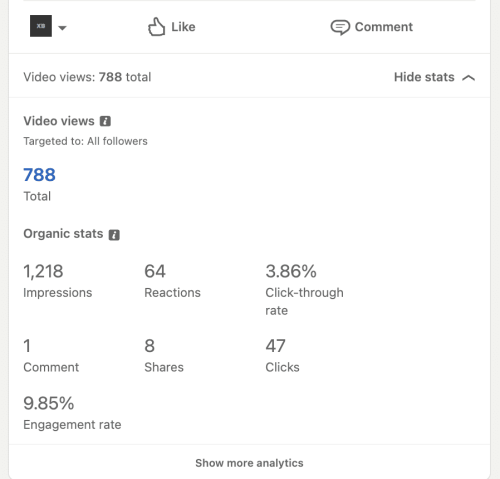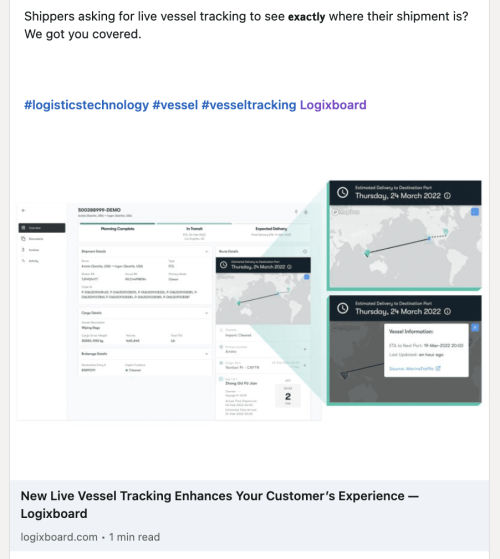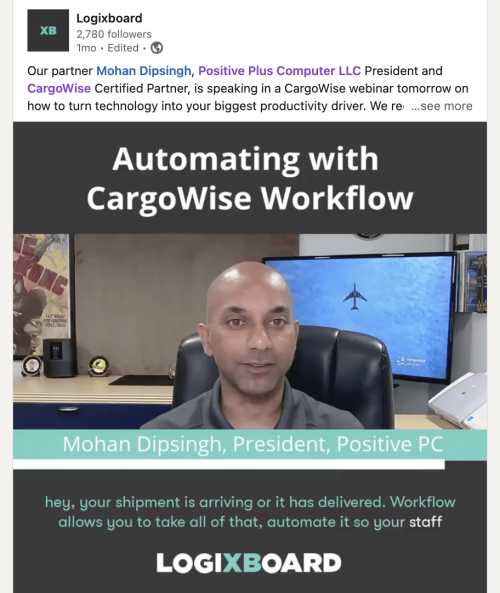In this article
Content Ideas:
There are many different content routes and topics a logistics company can post about on social media, but it can be helpful when getting started to strategize an overview of what type of content aligns with your social media goals. We are outlining some topic ideas for your logistics posts below.
Company Updates
Social media is a great way to share new updates with your customers and prospects. Whether you have a new preferred process, a new customer experience software solution, an updated website, or a new offering for customers, sharing it through your social media presence can get people excited and keep them informed. You can also spotlight your employees to really put a face to who your company is.
Industry Related News
In the logistics industry, news updates can be very impactful when making strategic decisions about your supply chain. Sharing articles, reports, and predicted trends can give your customers the chance to get this news from a partner they trust in one visit to your profile. Taking it to the next level, you can add your company’s thoughts, insights, or predictions to the post’s copy when applicable.
Industry Collaborative Content
With partners and customers, you can grow your social media reach by collaborating on content. Share posts to highlight your partnership, promote a collaborative blog, or invite audiences to events you are both a part of.
Videos, Videos, Videos
You shouldn’t just post to post, but when relevant, try to incorporate a video post instead of just text or still images. Based on social media research, videos capture a viewer’s attention for longer, resulting in better engagement. You do not have to be a video pro to create this content. Rather, you can start out simple by using Canva video templates and some supplementary stock footage with your messaging.
Hashtags
A hashtag is the pound symbol followed by a word or phrase. Sounds simple enough right? Well, using hashtags is an easy way to tag your content with specific topics it relates to or try to get in front of the audiences you are targeting. Hashtags make content more discoverable in social media searches and result in reaching more people. Learn more about what hashtags can do for your posts here.
Once you have your content ideas ready, you can start building your copy and design ideas for each post. A good way to make sure you stay consistent is to use a social media scheduling tool (E.g. Hootesuite, Later, and Planoly) to plan out your base posting ideas.
Using Different Platforms:
There are many social media platforms your freight forwarding company can be active on, but below we are discussing some of the most popular platforms used by B2B companies.

LinkedIn is one of the top platforms for B2B marketing and is an important addition to your social media strategy as a freight forwarder. Blog posts, industry news, company updates, and videos are strong content used by companies on this platform to connect with their customers and prospects. As freight forwarders, shippers/BCOs as your target audience makes LinkedIn a great platform to be active on. Whether they have a strong social presence themselves on LinkedIn or only manage their hiring through the platform, many companies maintain their LinkedIn activity.

Twitter is a short-form platform that primarily is used to share news, opinions, and thoughts. Due to a deal between Google and Twitter, tweets are great for company SEO as they have a higher chance of being visible in Google search results. Although a good addition to your social media stack, there are many bots that plague the platform, making it harder to have legit engagement.

Facebook is one of the most popular social media platforms in the world and is primarily used to stay connected with friends and family. With the largest user base, there is the allure of a higher opportunity for your content to reach a greater audience and in-depth analytics tools to track your results. Facebook is becoming less favorable to younger generations in favor of newer platforms.

Instagram is a more creative, content-focused platform that requires the use of an image or video in each post. If you are already creating visuals for LinkedIn and Facebook posts, there is no reason not to cross promotionally post on Instagram. Many B2C companies that market through Instagram are selling hard goods that need to be managed through freight forwarders.

YouTube is a video platform that is great for informational, educational, and promotional content. Video interviews, product/service overviews, customer testimonials, and educational pieces on the forwarding process are great content options for freight forwarders on this platform.

TikTok is a short video-sharing platform that offers a place for less formal content and chances for smaller creators to start trending across the platform. As the favored platform for younger users of social media, it is a good place to start contemplating how you would engage there with videos used on other platforms.
Repurposing your posts to go on multiple channels is an easy way to build your social media presence across the platforms and hit new audiences. Take a deeper look into each platform here.
Measuring Your Efforts:
As with all marketing efforts, being able to measure the performance of your posts and the reach of your social media accounts will continue to better your strategies.
Before you start creating the list of KPIs you want to track, discuss with your team what you hope to accomplish. If your goal is brand awareness, you will want to keep track of metrics related to your post’s reach and account’s reach. If you are looking to secure new leads from your social media posts, you should be having a call to action with links to landing pages including forms to secure leads or tagging sales team members on the platform.
Figure out what your goals are for engagement, overall outcome, and other metrics you are interested in, then start tracking them. Google Analytics and individual social media platform dashboards are a great start to analyzing your social media performance. Learn more about measuring your social media performance here.

Making a point to schedule consistent evaluations of your social media performance is a good way to ensure you are using the results to inform your further posts. Try to see what content is performing best, if your posts are securing your desired outcome, and any trends in higher-performing content or platforms the content is more successful on.
Start Posting!
Now that you’ve gone through some basics to get started on your social media presence as a freight forwarder, it’s important to launch your presence. As you start off, there is no need for you to overextend on initial efforts, but come up with a manageable, consistent plan as you decide how much attention you want to place on your strategy.
Make sure to track your results, be consistent, and reference social media accounts you admire as you get your footing. The exciting part about starting to build your social media presence as a freight forwarder is that you can pave the way as an early adopter in an industry that hasn’t fully taken advantage of this strategy yet!


